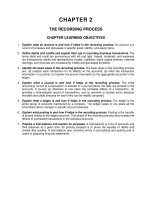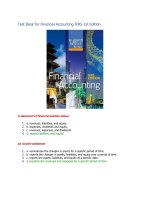Financial accounting IFRS 4 kieoso ch03 PPT
Bạn đang xem bản rút gọn của tài liệu. Xem và tải ngay bản đầy đủ của tài liệu tại đây (5.51 MB, 93 trang )
Financial Accounting
IFRS 4th Edition
Weygandt ● Kimmel ● Kieso
Chapter 3
Adjusting the Accounts
Chapter Preview
In Chapter 1, you learned a neat little formula:
Net income = Revenues – Expenses.
In Chapter 2, you learned some rules for recording revenue and expense transactions.
Guess what?
Things are not really that nice and neat. In fact, it is often difficult for companies to determine in what time period
they should report some revenues and expenses. In other words, in measuring net income, timing is everything.
Copyright ©2019 John Wiley & Son, Inc.
2
Chapter Outline
The learning objectives for Appendix A and B follow below the chapter slides.
Copyright ©2019 John Wiley & Son, Inc.
3
Learning Objective 1
Explain the accrual basis of accounting and the reasons for adjusting
entries.
LO 1
Copyright ©2019 John Wiley & Sons, Inc.
4
Accrual-Basis Accounting and Adjusting Entries
Time period (or periodicity) assumption:
Accountants divide the economic life of a business into artificial time periods.
LO 1
Copyright ©2019 John Wiley & Son, Inc.
5
Fiscal and Calendar Years
•
Accounting time periods are generally a month, a quarter, or a year.
•
Monthly and quarterly time periods are called interim periods.
•
Most large companies must prepare both quarterly and annual financial statements.
•
Fiscal Year = Accounting time period that is one year in length.
•
Calendar Year = January 1 to December 31.
•
Sometimes a company’s year-end will vary from year to year, resulting in accounting periods of either 52 or 53
weeks.
LO 1
Copyright ©2019 John Wiley & Son, Inc.
6
Accrual- versus Cash-Basis Accounting
Accrual-Basis Accounting
•
Transactions are recorded in the periods in which the events occur.
•
Companies recognize revenues when they perform services (rather than when they receive cash).
•
Expenses are recognized when incurred (rather than when paid).
•
Accrual-basis accounting is in accordance with IFRS.
LO 1
Copyright ©2019 John Wiley & Son, Inc.
7
Accrual- versus Cash-Basis Accounting
Cash-Basis Accounting
•
Revenues are recorded when cash is received.
•
Expenses are recorded when cash is paid.
•
Cash-basis accounting is not in accordance with IFRS.
LO 1
Copyright ©2019 John Wiley & Son, Inc.
8
Recognizing Revenues and Expenses
LO 1
Copyright ©2019 John Wiley & Son, Inc.
9
Recognizing Revenues and Expenses
LO 1
Copyright ©2019 John Wiley & Son, Inc.
10
Recognizing Revenues and Expenses
LO 1
Copyright ©2019 John Wiley & Son, Inc.
11
Ethics Insight
Krispy Kreme
Cooking the Books?
What motivates sales executives and finance and accounting executives to participate in activities that result in
inaccurate reporting of revenues?
Answer and additional questions: See the book’s companion website.
LO 1
Copyright ©2019 John Wiley & Son, Inc.
12
The Need for Adjusting Entries
•
Adjusting entries ensure that the revenue recognition and expense recognition principles
are followed.
•
Required every time a company prepares financial statements.
•
Will include one income statement account and one statement of financial position
account.
LO 1
Copyright ©2019 John Wiley & Son, Inc.
13
The Need for Adjusting Entries
Reasons:
1.
Some events are not recorded daily because it is not efficient to do so.
2.
Some costs are not recorded during the accounting period because these costs expire with
the passage of time rather than as a result of recurring daily transactions.
3.
LO 1
Some items may be unrecorded.
Copyright ©2019 John Wiley & Son, Inc.
14
Types of Adjusting Entries
LO 1
Copyright ©2019 John Wiley & Son, Inc.
15
Analyze each account to determine whether it is complete and up-to-date for financial statement purposes.
LO 1
Copyright ©2019 John Wiley & Son, Inc.
16
DO IT! Timing Concepts
Continues on next slide
LO 1
Copyright ©2019 John Wiley & Son, Inc.
17
DO IT! Timing Concepts
ACTION PLAN
•
Review the definitions of the timing concepts in the Glossary Review section.
•
Study carefully the revenue recognition principle, the expense recognition principle, and the
time period assumption.
LO 1
Copyright ©2019 John Wiley & Son, Inc.
18
DO IT! Timing Concepts
Solution
1.f
2.e
3.c
4.b
Related exercise material:
BE3.1, DO IT! 3.1, E3.1, E3.2, and E3.3.
LO 1
Copyright ©2019 John Wiley & Son, Inc.
19
Learning Objective 2
Prepare adjusting entries for deferrals.
LO 2
Copyright ©2019 John Wiley & Sons, Inc.
20
Adjusting Entries for Deferrals
Deferrals are expenses or revenues that are recognized at a date later than the point when cash was originally
exchanged.
There are two types:
ã
ã
LO 2
Prepaid expenses, and
Unearned revenues.
Copyright â2019 John Wiley & Son, Inc.
21
Prepaid Expenses
Prepaid expenses are costs that expire either with the passage of time (e.g., rent and insurance) or through use (e.g.,
supplies).
Prior to adjustment, assets are overstated and expenses are understated.
LO 2
Copyright ©2019 John Wiley & Son, Inc.
22
Supplies
Rather than record supplies expense as the supplies are used, companies recognize supplies expense at the
end of the accounting period.
LO 2
Copyright ©2019 John Wiley & Son, Inc.
23
Supplies
Assume: Yazici Advertising purchased supplies costing 2,500 on October 5. Yazici recorded the purchase by
increasing (debiting) the asset Supplies. This account shows a balance of 2,500 in the October 31 trial balance. An
inventory count at the close of business on October 31 reveals that 1,000 of supplies are still on hand.
Demonstrate: How do you record the adjustment for supplies?
Continues on next slide
LO 2
Copyright ©2019 John Wiley & Son, Inc.
24
Supplies
LO 2
Copyright ©2019 John Wiley & Son, Inc.
25









